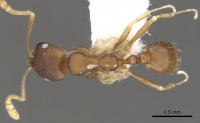Monomorium micropacum
| Monomorium micropacum | |
|---|---|

| |
| Scientific classification | |
| Kingdom: | Animalia |
| Phylum: | Arthropoda |
| Class: | Insecta |
| Order: | Hymenoptera |
| Family: | Formicidae |
| Subfamily: | Myrmicinae |
| Tribe: | Solenopsidini |
| Genus: | Monomorium |
| Species: | M. micropacum |
| Binomial name | |
| Monomorium micropacum Bolton, 1987 | |
Nothing is known about the biology of Monomorium micropacum.
Identification
Bolton (1987) - A member of the M. opacum complex in the M. salomonis species group. This South African species resembles a smaller version (compare measurements) of Monomorium opacum and has a much more densely hairy gaster. Where opacum has only 1-2 pairs of hairs on the first tergite micropacum has about 10 in front of the apical transverse row. On the head micropacum has 3 pairs of standing hairs behind the level of the frontal lobes where opacum has none or at most one pair, close to the occipital margin.
Keys including this Species
Distribution
Distribution based on Regional Taxon Lists
Afrotropical Region: South Africa (type locality).
Distribution based on AntMaps
Distribution based on AntWeb specimens
Check data from AntWeb
Countries Occupied
| Number of countries occupied by this species based on AntWiki Regional Taxon Lists. In general, fewer countries occupied indicates a narrower range, while more countries indicates a more widespread species. |

|
Estimated Abundance
| Relative abundance based on number of AntMaps records per species (this species within the purple bar). Fewer records (to the left) indicates a less abundant/encountered species while more records (to the right) indicates more abundant/encountered species. |

|
Biology
Castes
Nomenclature
The following information is derived from Barry Bolton's Online Catalogue of the Ants of the World.
- micropacum. Monomorium micropacum Bolton, 1987: 350 (w.) SOUTH AFRICA.
- Type-material: holotype worker, 1 paratype worker.
- Type-locality: holotype South Africa: Natal, Umlalazi Nat. Res., 25.iii.1979 (D.J. Brothers); paratype with same data.
- Type-depository: BMNH.
- Status as species: Bolton, 1995b: 264.
- Distribution: South Africa.
Unless otherwise noted the text for the remainder of this section is reported from the publication that includes the original description.
Description
Worker
Bolton (1987) - Holotype. TL 2·4, HL 0.62, HW 0.48, CI 77, SL 0.50, SI 104, PW 0.34, AL 0.70.
Anterior free margin of median portion of clypeus concave. Maximum diameter of eye 0.21 x HW and with 8 ommatidia in the longest row. Sides of head feebly convex in full-face view and somewhat convergent posteriorly, so that the head is slightly narrower across the occipital corners than immediately behind the eyes. Dorsum of pronotum convex anteriorly but the posterior portion of the pronotum and the mesonotum more or less flat or even very shallowly concave in profile, sloping posteriorly to the distinctly impressed metanotal groove. Propodeal dorsum in profile more steeply sloping than the mesonotum, the dorsum and declivity meeting in a broadly rounded angle. Propodeal dorsum approximately flat transversely between the blunt, posteriorly divergent marginations which separate dorsum from sides. Peduncle of petiole with a very narrow strip-like ventral process. Dorsum of head with three pairs of standing hairs behind the level of the frontal lobes. Dorsal alitrunk without standing hairs; petiole with one pair, postpetiole with two pairs of hairs. First gastral tergite evenly pilose, with 10 or more pairs of hairs in front of the apical transverse row. Dorsum of head from level of posterior margins of eyes to occipital margin blanketed by fine and dense reticulate-punctate sculpture, the punctures all sharply defined and decreasing slightly in size posteriorly; without other sculpture on head except for a few very fine striae between the frontal lobes and spanning the cephalic midline immediately behind the frontal lobes. All dorsal and lateral surfaces of alitrunk finely and sharply densely reticulate-punctate. Petiole and postpetiole reticulate-punctate to reticulate-granulate, the sculpture not quite as sharply defined as on the alitrunk. First gastral tergite very finely and densely shagreenate basally, apically this sculpture reducing to fine superficial reticulation only. Colour a uniform dull light brown, the cephalic dorsum slightly darker in shade than the rest of the body.
Paratypes. TL 2.3, HL 0.61, HW 0.48, C1 79, SL 0.51, SI 106, PW 0.33, AL 0.68. As holotype but maximum diameter of eye 0.23 x HW, again with 8 ommatidia in the longest row. Colour darker brown than the holotype and more nearly the same shade everywhere, perhaps implying that the holotype had not achieved its full adult colouring.
Type Material
Bolton (1987) - Holotype worker, South Africa: Natal, Umlalazi Nat. Res., 25.iii.1979 (D. J. Brothers) (The Natural History Museum). Paratype. 1 worker with same data as holotype (BMNH).

